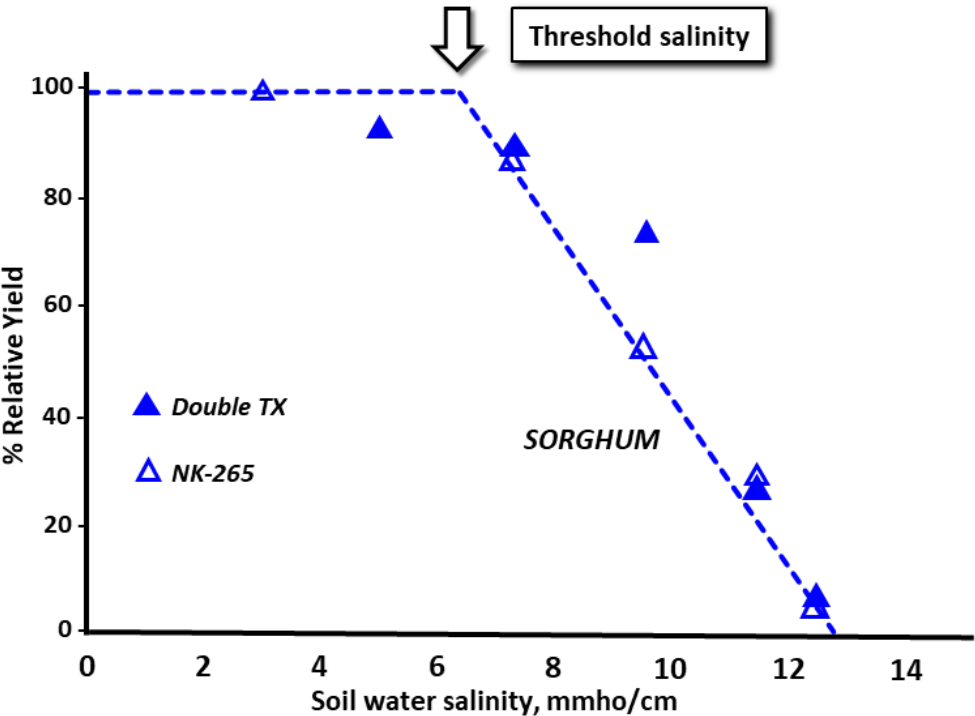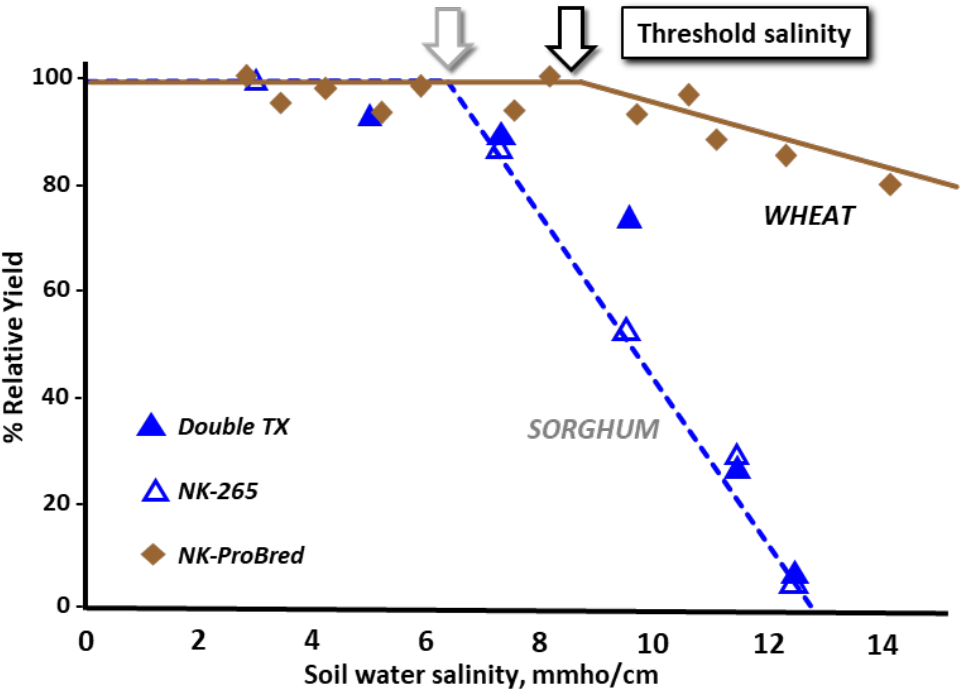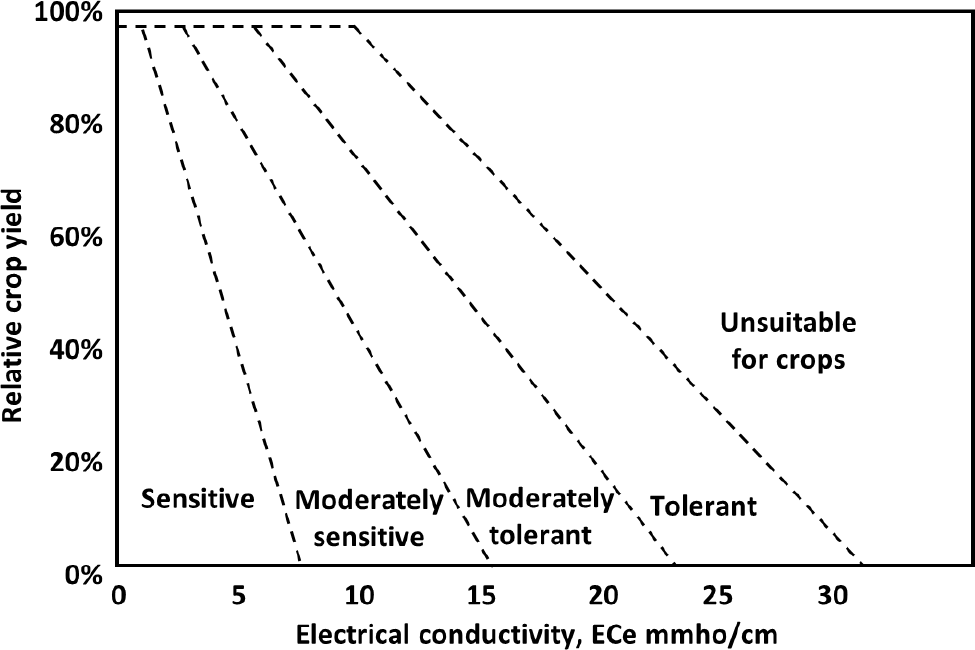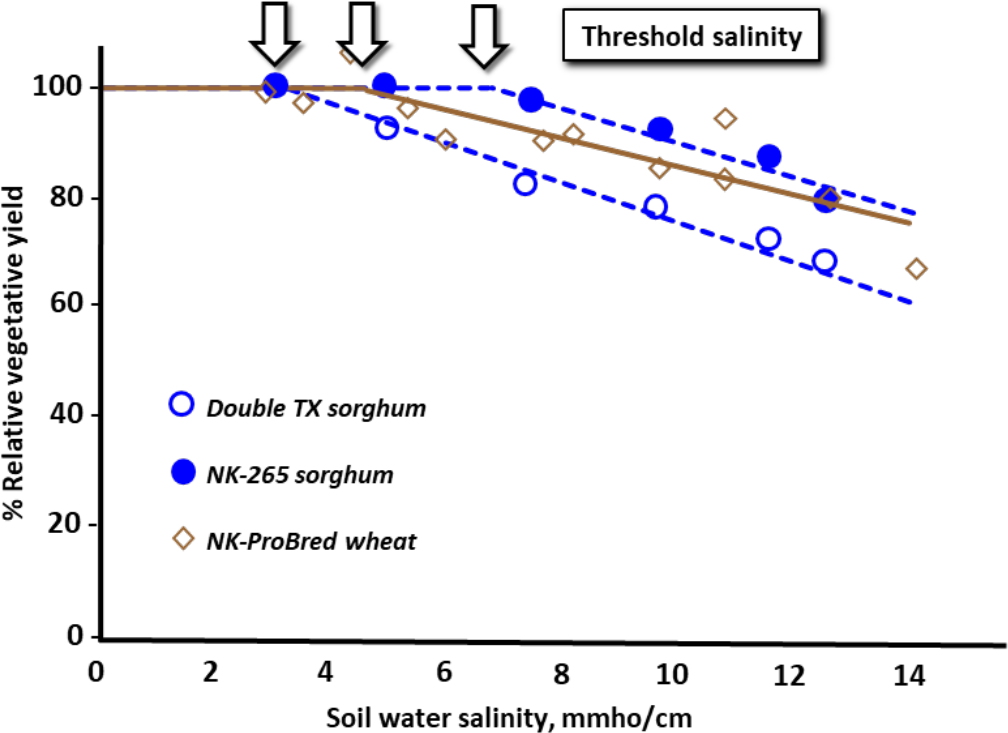⇦ Back to Soil Resource Management Home
¶ Introduction
Crop salt tolerance is the ability of plants to survive and produce economic yields under potentially adverse conditions caused by various levels of soil salinity.
Water uptake from saline soils can equal that of non-saline soils when they make these adjustments. Unfortunately, these internal adjustments are always made at the expense of crop growth. This because the energy a plant uses to extract water from a saline soil is energy that would normally be used to produce forage, grain, or fruit.
Salt tolerant crops are often slower growing and more drought resistant than salt sensitive crops. Salt tolerant crops also tend to be deeper rooted and have a lower root-to-shoot ratio than salt sensitive crops.
¶ Salinity “Threshold”
Each crop or plant has a certain "threshold” salinity level. Yield and growth are affected very little up to the threshold level. This is illustrated in Figure 1, an experiment with two sorghum varieties grown under different salinity conditions (Francois, 1984).
¶ Figure 1. Sorghum Grain Yield Response to Increasing Soil Salinity

Yields are not expressed as bushels or pounds, rather as “percent relative yield”. The highest yield is shown as 100%. Other yields are shown as a percentage of the highest yield. The relative yield approach allows comparison between different locations or conditions.
Yields are comparatively unaffected until the soil salinity reaches a threshold of 6.8 mmho/cm. Yields then decline by 16% for each additional 1 mmho/cm increase of soil salinity. The yield does not drop off immediately upon reaching the threshold, but rather decreases gradually and progressively as the soil salinity exceeds the threshold. Complete yield failure is expected to occur at 13 mmho/cm.
¶ Tolerance Differs Between Crop Species
Sensitivity and tolerance to soil salinity differs between plant and crop species. Plants have the ability to make internal adjustments for changes in soil osmotic tension, the ability of a soil to retain moisture. Some crops can adjust more readily than others. The salinity thresholds are higher and rate of yield decline lower than those crops that cannot make these internal adjustments.
In general, crops with higher stress tolerance will generally be more salinity tolerant than less stress tolerant crops. Drought tolerant varieties are likely to be more capable of handling salinity-induced drought stress and producing an acceptable yield.
Figure 2 compares the salinity impact on grain yields between sorghum and wheat. Wheat had a threshold salinity of 8.6 mmho/cm compared to 6.8 mmho/cm for sorghum. Wheat yields also declined at a slower rate than sorghum, 3% per salinity unit increase compared to 16%. Sorghum would be expected to have a zero yield at 13 mho/cm, while wheat yields would be expected to be 87% of of the equivalent nonsaline yield.
¶ Figure 2. Sorghum and Wheat Grain Yield Response to Increasing Soil Salinity

¶ Classifying Salinity Tolerance
Plant species and crops are classified as being sensitive or tolerant depending on how rapidly growth or yield changes with increasing salinity. Field and horticultural crops are classified on the basis of grain, forage, or fruit yields. Ornamental crops are classified on growth or appearance, because yield is not important or is not measured.
Figure 3 illustrates the general guidelines used to classify salt tolerance. Plants and crop varieties are divided into four general categories according to the individual salinity threshold and the relative rate of yield decline with increasing salinity.
¶ Figure 3. Classification Scheme for Crop Salt Tolerance

Crop File 4.03.023 (Soil Salinity Tolerance Ratings) has an extensive list of crops and plants with their individual salinity tolerance rating. Other Crop files have specific salinity threshold and yield reduction data for these crops.
Perennial, deep-rooted crops tend to be more salt tolerant than annual shallow-rooted crops. Vegetables, fruits, and ornamentals are generally considered sensitive or moderately salt sensitive. Many of our row crops are generally to have moderate salt tolerance. Small grains and forage legumes tend to be moderately salt tolerant or salt tolerant.
Certain woody ornamentals are quite salt sensitive despite being deep-rooted perennials. Excess concentrations of chloride, sodium, or boron may cause toxicities in these plants even though salinity is comparatively low. into the final crop management decisions.
For example (see Figure 2), increased salinity will have proportionally less impact on wheat grain yields than on sorghum yields as salinity increases. Wheat yield potential may be lower than grain sorghum yield potential, so the harvested wheat yield may be lower than sorghum yield under a given set of conditions. Thus, it may be more profitable to produce sorghum than wheat on a saline soil depending on the actual yield and crop price, even though the sorghum yield is impacted to a larger degree by the soil salinity.
¶ Forage May Be Less Affected Than Grain
Vegetative growth can be less affected by salinity than is grain or fruit yield. The relative yield reduction for a given crop may be less when it is harvested as forage than when harvested as grain.
For example, Figure 4 shows the effect of increasing salinity on wheat and sorghum vegetative growth, which differed from the grain yield response. The salinity thresholds for the sorghum varieties was 3.0 and 6.6 mmho/cm; 4.5 mmho/cm for wheat. The relative yield reductions ranged from 3.6% to 3.5% per unit of salinity increase.
¶ Figure 4. Sorghum and Wheat Vegetative Growth Response to Increasing Soil Salinity

Stress during the early and critical part of the reproductive growth stages, like pollination or tasseling, has a large impact on final yield. The vegetative growth period is longer than this critical reproductive growth, so plants have more opportunity to recover vegetative yield than grain yield.
Perennial forages tend to be more salinity tolerant than annual forages. Perennials are able to develop deeper more extensive root systems and often able to compensate for high salinity levels in the upper profile that have a greater effect on more shallow-rooted annual crops.
¶ Young Plants More Sensitive
Excess salinity tends to affect seedlings and young plants more than older, established plants. Excessive dissolved salts in the soil solution can damage seed membranes before emergence, affecting the seed's ability to imbibe and retain water.
Emerging seedlings can be damaged if the osmotic tension of the soil solution is too high. Water is drawn from the interior of the root cells back into the soil, essentially a dehydration process. Roots will die if dehydrated for too long.
Root loss is more critical to young plants simply because they have fewer roots. Older, established plants have a more extensive root system, so if part of it is damaged by excess salts, the remaining roots can often compensate for the damaged portion.
Table 1 lists several crops with salt tolerance differing between germinated seedlings and established plants. Alfalfa is an example of a crop with different salinity response at germination and establishment (see Figure 5). Alfalfa seedlings are considered very sensitive, so establishing a stand is very difficult under saline conditions. Once established, alfalfa can tolerate rather high soil salinity levels.
¶ Table 1. Relative Salt Tolerance at Two Growth Stages |
||
| Crop | Germinated | Established |
| Alfalfa | low | medium |
| Barley | high | high |
| Beans | low | low |
| Corn | medium | low to medium |
| Rye | high | medium |
| Sugarbeets | low | high |
| Wheat | medium | medium |
¶ Figure 5. Alfalfa Seed Germination and Forage Yield Response to Increasing Soil Salinity

Corn is another example. The traditional threshold salinity
(ECe) for established corn plants is 1.7 mmho/cm, but California researchers found that seedling growth was reduced by soil water salinity that exceeded 0.7 mmho/cm. They found salt levels of the irrigation water could be increased to about 9 mmho/cm during the tasseling and grain filling stages without affecting yield.
¶ Variety Differences and Salt Tolerance
Salt tolerance of individual varieties of the same crop species may differ. For example, six-row barley varieties are known to be more salt tolerant than two-row varieties. Figure 4 shows differences in vegetative growth between two sorghum varieties. Even though they are the same species, the two varieties have very different salinity thresholds, 3.0 and 6.6 mmho/cm.
There is usually little or no research information available to compare tolerance levels between hybrids or varieties. In general, crop varieties that are more drought-tolerant or stress-tolerant also tend to be more salinity tolerant.
¶ Growth Conditions and Salt Tolerance
Plant growth habits can alter the effects of salinity. For example, the fibrous root systems typical of forage crops help improve water infiltration by providing channels for water movement and increasing the organic matter content. Perennial forages also shade the ground longer than other crops. This slows evaporation so more water is available for crop use or for leaching. Salt tolerant crops also help to "harvest" salts by removing them as nutrients when the above-ground portion is harvested.
Hot, dry conditions tend to aggravate salinity problems. Crops will suffer water stress from the combined effects of rapid moisture depletion with the additional osmotic tension requirement for saline soil water. Cool, humid conditions may mask the normal adverse effects of salinity. Water stress is lower and the salts are more diluted in wet soils than in dry soils.
Any other stress that gets placed on the crop will limit its ability to cope with excess salinity. Such stresses include soil compaction, low fertility, reaction to herbicide application, and others.
¶ References
Francois, et. al. 1986. Effect of salinity on grain yield and quality, vegetative growth, and germination of semi-dwarf and durum wheat. Agron. J. 78:1053-1058.
Francois, et. al. 1984. Salinity effects on seed yield, growth, and germination of grain sorghum. Agron. J. 76:741-744
Maas, E.V. and G..J. Hoffman. 1983. "Salt sensitivity of corn at various growth stages" in California Agriculture. Agri. Expt. Station, Univ. of Calif., Berkely, Calif. July-August 1983. pg. 14-15.
Tanji, K.K., ed. 1990. "Chap. 13, Crop Salt Tolerance" in Agricultural Salinity Assessment and Management. ASCE Mauals and Reports on Engineering Practice No. 71. American Society of Civil Engineers, New York. pg. 262-304